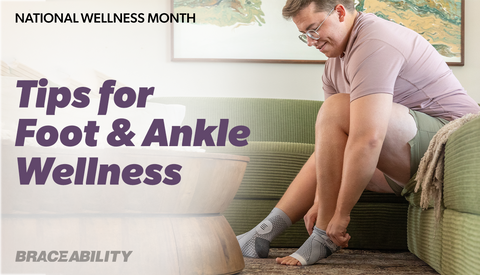Idiopathic Toe Walking: Causes and Effective Solutions
What is Idiopathic Toe Walking?
Understanding Toe Walking: A Clear Definition
Idiopathic toe walking, or ITW, refers to a walking pattern where a person (often a child) consistently walks on their toes without an obvious underlying cause or medical condition.
In simpler terms, it means someone walks on their tiptoes without a clear reason why.

Common Symptoms to Look For
Besides the obvious symptom of someone walking on their tiptoes all the time, some other symptoms of idiopathic toe walking include decreased balance and coordination, frequent falls, or complaints of pain - more on these later!
Who is Most at Risk for Toe Walking?
Toe-walking occurs most often in children ages three and up. It is estimated that 7% to 24% of children in that demographic are idiopathic toe-walkers.
That number is much smaller in the adult population, as only about 1-2% of adults have ITW.
Toe-walking can indicate various conditions, most commonly cerebral palsy, Achilles tendon contracture, Duchenne muscular dystrophy, autism spectrum disorder, or other psychological or physical conditions.
Importance of Early Detection
It is important to be vigilant about signs of ITW. When detected early, appropriate care and treatment can be taken, reducing the risk of long-term effects.
Understanding ITW
Idiopathic vs. Symptomatic
Idiopathic toe-walking has no apparent reason for its occurrence. For example, this would be a child who, out of habit, walks on their toes, without any detectable reason for doing so.
Symptomatic toe-walking is when walking on toes is a symptom of a known underlying condition or medical issue. Examples of these conditions or medical issues include a neurological disorder, muscular imbalance, or cerebral palsy.
Breaking it Down: Understanding The Mechanics of Walking
Gait Development
A person’s way of walking, or their gait, develops at ages from 9-18 months of age. During the toddler years (1-3 years), walking has started to become independent. It has developed into using a wide brace of support, high cadence, short step length, and in normal walking, will occur without exaggerated use of the toes.
Toe-walking, if present, most commonly starts to occur either at the start of independent walking or within six months of independent walking.
Possible Reasons for Toe Walking
Limited Range of Motion (ROM)
Inadequate movement in the ankle joint can limit the foot’s ability to properly land on the ground while walking. A result of this is compensatory toe-walking to aid in forward momentum.
Muscular Imbalances
Muscular imbalances refer to weakness or imbalance in the muscles in the foot or lower leg. This can lead to the toe striking first while walking, with the imbalanced muscles favoring the toes over the heel.
Tight Achilles Tendon
The Achilles Tendon, which connects the calf to the heel of the foot, is tighter than normal, resulting in difficulty lowering the heel to the ground.
Neurological Issues
Neurological issues would be problems with the nerves that control the muscle movements in the legs and feet, leading to altered walking patterns.
Identifying ITW
Early Toe Walking Signs and Symptoms
As mentioned before, the most common age of onset for ITW is when the child begins to walk independently or shortly thereafter, which is when the child is 1-3 years of age.
It is important that the parents of the child are vigilant in identifying any signs of ITW during this timeframe.
If toe-walking is suspected, there are steps that can be taken to diagnose it.
Diagnosis
The easiest way to diagnose ITW is through identification during a child’s physical examination. This would be the cheapest and most hassle-free of diagnosis.
In some cases, though, doctors may choose to go as far as a gait analysis of the child or perform an exam known as an EMG.
Long-Term Effects of Idiopathic Toe Walking in Children
If the child continues to walk on their toes, they are likely to experience one or more of the following long-term effects of idiopathic toe walking:
- Orthopedic issues
- Muscle contractures
- Widening forefoot
- Poor alignment
- Pain in feet, ankle, knees, or back
- Joint problems
- Prolonged toe walking can put additional stress on the ankle and knee joints, increasing the risk of joint-related issues over time.
- Social impact
- Children with ITW may stand out from their peers because of their unique gait
- Children may be inhibited from performing well in physical activities because of ITW, separating them from their peers
Treatment Methods
Physical Therapy
Physical therapy is an accessible way to help correct toe-walking in children. For the most success, first model them for your child, and then do the exercise with them. Here are some exercises!
Duck Walk
- Stand with your feet about shoulder-width apart
- Squat down by bending at your knees to lower your hips down and behind you - act like you’re sitting on a chair
- Go as deep as you can while keeping a straight spine and without lifting your toes or heels. If needed, you can lift your arms in front of you to help keep your balance
- Keeping your hips the same distance from the floor, take a step forward with one foot, landing with a flat foot
- Step forward with your other foot
- Repeat!

Crab Walk
- Sit on the ground with your legs bent in front of you and feet flat on the floor
- Place both hands firmly behind you, fingertips facing forward and evenly spaced apart
- Lift your hips off the floor
- Begin the crab walk by stepping back with one foot and the opposite hand
- Alternate by moving opposite hands and feet
- Travel about 5 feet, increasing in distance as your child feels more comfortable

Tip-Toe Correction Braces or Splints
Braces and splints can provide a more sustainable approach to treatment. Different braces provide different benefits - here are some various perks to a brace:
- Maintain ankle stability
- Encourage proper foot alignment
- Corrects gait
- Prevent contractures
Braces and splints can help ease your child into normal walking through gradual corrections. They don’t have to break the bank, either. Affordable splints provide most (if not all) of the benefits listed above.
Serial Casting
Serial casting involves casting the foot. The goal of casting is not only to improve alignment of the foot but also strengthen the imbalanced muscles over time.
Serial casting should be performed by a certified serial caster.
Surgical Intervention
In rare cases, physical therapy, braces, and other treatment methods may not work. In these cases, surgical intervention may be required to fix the toe-walking.
Especially in children over the age of 5, the Achilles tendon and calf muscles may be so tight that the child cannot walk flat-footed. For patients like this, surgery to lengthen the Achilles tendon may take place.
This would improve the range of motion and allow for better mobility. The average complete recovery time spans from a few months to a full year.
Because of the cost and recovery time of surgical intervention, it is only recommended by doctors for patients that have unsuccessfully tried every other treatment method.
Life After ITW
Once remedied, children who have idiopathic toe walking will be able to lead a normal life. Currently, there are no known long-term effects of ITW, as long as it’s caught and fixed early enough.
Once again, it is very important for the parent or guardian of the child to remain watchful of their walking and gait patterns to recognize the symptoms of ITW and get their child proper treatment.
Final Thoughts
Idiopathic toe walking is a condition where a person (most often a child) walks only on their tip-toes without an obvious reason or known underlying medical condition.
Toe-walking occurs most often in children ages three and up but can show up as early as whenever the child begins to walk independently.
ITW can be remedied through physical therapy, a brace/splint, serial casting, or surgical intervention.
In conclusion, by spotting signs early and choosing the right treatment, children with idiopathic toe walking can stride forward to a life with better walking and increased mobility!











